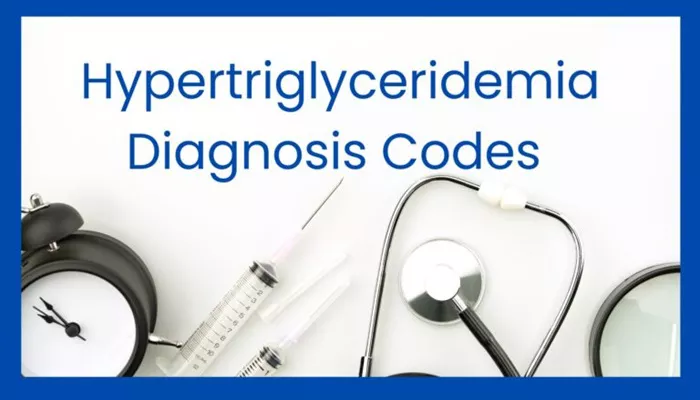Hypertriglyceridemia is a medical condition characterized by elevated levels of triglycerides in the blood. Triglycerides are a type of fat (lipid) found in the bloodstream, and high levels can increase the risk of cardiovascular diseases and pancreatitis.
The International Classification of Diseases, Tenth Revision (ICD-10), classifies pure hypertriglyceridemia under code E78.1 (Pure hyperglyceridemia), which is used when triglycerides are elevated without significant increases in other lipids like cholesterol.
What Is Hypertriglyceridemia?
Hypertriglyceridemia means having too many triglycerides in the blood. Triglycerides come from the fats we eat and are also produced by the liver. Normally, triglycerides provide energy to the body, but when levels are too high, they can cause health problems. It is often linked with other lipid abnormalities but can occur alone, which is referred to as “pure” hypertriglyceridemia.
Causes of Hypertriglyceridemia
Hypertriglyceridemia can be caused by a variety of factors, which are broadly categorized into primary (genetic) and secondary causes:
Primary Causes:
Genetic disorders such as familial hypertriglyceridemia or familial chylomicronemia syndrome.
Inherited metabolic conditions affecting lipid metabolism.
Secondary Causes:
- Poor diet high in sugars, fats, and alcohol
- Obesity and metabolic syndrome
- Diabetes mellitus, especially poorly controlled type 2 diabetes
- Hypothyroidism
- Kidney disease
- Certain medications like corticosteroids, beta-blockers, and estrogens
- Sedentary lifestyle
These factors either increase the production or decrease the clearance of triglycerides in the blood.
Symptoms of Hypertriglyceridemia
Most people with elevated triglycerides do not experience symptoms initially, which is why hypertriglyceridemia is often called a “silent” condition. Symptoms usually appear when triglyceride levels are very high, typically above 1000-2000 mg/dL:
Gastrointestinal symptoms: Recurrent abdominal pain, nausea, and vomiting, often related to pancreatitis.
Skin manifestations: Eruptive xanthomas (small, yellowish papules on the skin), especially on the trunk, buttocks, and limbs.
Eye signs: Corneal arcus and xanthelasmas (yellowish deposits around the eyelids).
Other signs: Hepatosplenomegaly (enlarged liver and spleen) and lipaemia retinalis (milky appearance of retinal blood vessels).
Cardiovascular symptoms: Chest pain or signs related to coronary artery disease may develop over time.
Severe hypertriglyceridemia can lead to acute pancreatitis, a serious and potentially life-threatening inflammation of the pancreas.
Diagnosis And ICD-10 Coding
Diagnosis is made primarily through blood tests measuring fasting triglyceride levels. The ICD-10 code for pure hypertriglyceridemia is E78.1. Other related codes include:
| ICD-10 Code | Description |
| E78.1 | Pure hyperglyceridemia (hypertriglyceridemia) |
| E78.2 | Mixed hyperlipidemia (elevated cholesterol and triglycerides) |
| E78.3 | Hyperchylomicronemia (very high chylomicrons and triglycerides) |
| Z83.49 | Family history of endocrine, nutritional, and metabolic diseases (used when family history is relevant but no direct code for hypertriglyceridemia) |
Correct ICD-10 coding is essential for accurate diagnosis, treatment planning, and insurance reimbursement.
Treatment of Hypertriglyceridemia
The primary goals of treatment are to reduce triglyceride levels to prevent pancreatitis and to lower cardiovascular risk.
Treatment involves lifestyle changes and, in some cases, medications.
Lifestyle Modifications
Diet: Adopt a very low-fat diet (less than 15% of total calories from fat) especially if triglycerides exceed 1000 mg/dL.
Reduce intake of simple carbohydrates and sugars. Increase intake of fruits, vegetables, and whole grains.
Weight loss: Losing 5-10% of body weight can significantly reduce triglyceride levels.
Exercise: At least 150 minutes of moderate aerobic exercise per week helps improve lipid profiles.
Alcohol cessation: Alcohol can raise triglyceride levels and should be avoided.
Smoking cessation: Smoking worsens cardiovascular risk.
Pharmacological Treatment
Fibrates: First-line drugs that effectively lower triglycerides.
Niacin (nicotinic acid): Used to reduce triglycerides and raise HDL cholesterol.
Omega-3 fatty acids: High doses (2-4 grams daily) can lower triglycerides.
Statins: Primarily used to lower LDL cholesterol but may have modest triglyceride-lowering effects.
Combination therapy: Sometimes necessary for severe cases.
Severe Hypertriglyceridemia (Triglycerides > 1000 mg/dL)
Immediate intervention is required to prevent pancreatitis.
Therapeutic apheresis (plasmapheresis): A procedure to rapidly remove triglycerides from the blood. It is used in medical emergencies like hypertriglyceridemic pancreatitis.
Nutritional interventions and drug therapy are combined for sustained control.
Early plasmapheresis is associated with better outcomes but is limited by cost and availability.
Complications of Untreated Hypertriglyceridemia
Acute pancreatitis: High triglycerides can cause inflammation of the pancreas, leading to severe abdominal pain and systemic illness.
Cardiovascular disease: Elevated triglycerides contribute to atherosclerosis, increasing the risk of heart attacks, strokes, and peripheral artery disease.
Metabolic syndrome: A cluster of conditions including high blood pressure, high blood sugar, excess abdominal fat, and abnormal cholesterol levels.
Conclusion
Hypertriglyceridemia, classified under ICD-10 code E78.1 when pure, is a significant metabolic disorder involving elevated triglycerides. It is often asymptomatic but can lead to serious conditions like pancreatitis and cardiovascular disease. Causes range from genetic to lifestyle-related factors. Diagnosis relies on blood tests and accurate ICD-10 coding to guide treatment. Management focuses on lifestyle changes and medications, with urgent interventions like plasmapheresis reserved for severe cases.
Related topics:


